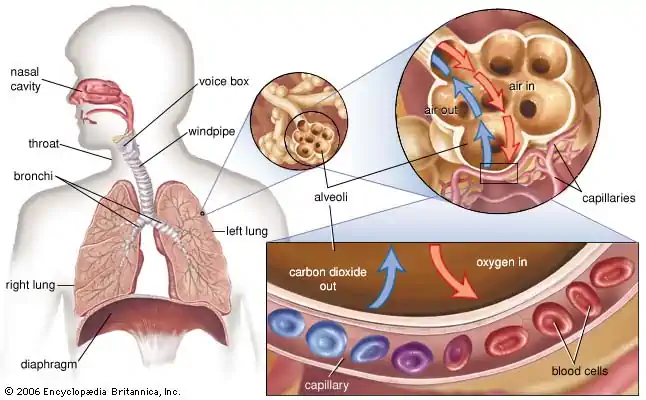Hyperventilation
Hyperventilation results from a significant decrease in carbon dioxide content in the blood, which, left untreated, can lead to incapacitation.
Introduction to Hyperventilation
- Hyperventilation results from a significant decrease in carbon dioxide content (CO2) in the blood that, left untreated, can result in incapacitation.
- You can make the symptoms of hyperventilation subside within a few minutes by consciously bringing your rate and depth of breathing back under control.
- In some instances, however, its effects can be debilitating.
- Prevention and proper awareness are key as a first-line defense against hyperventilation.
- Think you've got a solid understanding of hyperventilation? Don't miss the hyperventilation quiz below and the topic summary.
Potential Causes of Hyperventilation
- Hyperventilation is an abnormal increase in the volume of air breathed in and out of the lungs. [Figure 1]
- Stress.
- Panic.
- Anxiety.
- Hypoxia.
- Decreased carbon dioxide in the blood.
- Under conditions of stress and anxiety, a person's body reacts automatically to such stimuli, whether the danger be imaginary or real.
- One of these automatic reactions is a marked increase in breathing rate, which results in a significant decrease in the carbon dioxide content of the blood, a necessary step to regulate the breathing process automatically.
- Risk factors provide pilots with additional context if they experience hyperventilation symptoms or if passengers experience them.
Hyperventilation Recognition
-
Hyperventilation Symptoms:
- As hyperventilation "blows off" excessive carbon dioxide from the body, a pilot can experience symptoms of:
- Lightheadedness.
- Nausea.
- Suffocation.
- Drowsiness.
- Tingling in the extremities.
- Coolness.
- Dry mouth.
- Blurred vision.
- Rapid pulse and breathing rate.
- Early symptoms of hyperventilation are similar to those of hypoxia and some to ordinary airsickness.
- Symptoms of both are not unique, and several can occur simultaneously.
- Therefore, if a pilot using an oxygen system experiences symptoms, they should immediately set the regulator to deliver 100% oxygen, check the system to ensure it functions effectively, and then adjust their rate and depth of breathing.
- Symptoms of both are not unique, and several can occur simultaneously.
- Symptoms can easily cause confusion and panic, which only aggravates the problem by further increasing anxiety and, thus, the breathing rate.
- As hyperventilation "blows off" excessive carbon dioxide from the body, a pilot can experience symptoms of:
-
Debilitating Effects from Hyperventilation:
- First and foremost, hyperventilation can be a significant distraction to the safe operation of the aircraft.
- Incapacitation can eventually result from a lack of coordination, disorientation, and painful muscle spasms.
- Eventually, unconsciousness can occur.
- Once identified, pilots and passengers must take immediate action to address the conditions that resulted in hyperventilation, as well as the debilitating effects that followed its onset.
Recovering from Hyperventilation
- The symptoms of hyperventilation subside within a few minutes after you consciously bring your rate and depth of breathing back under control.
- The buildup of carbon dioxide in the body can be hastened by talking loudly or controlled breathing in and out of a paper bag held over the nose and mouth.
- This method does not force you to breathe carbon dioxide but instead forces you to think about your breathing rate.
- This method may increase carbon dioxide levels too quickly, leaving it as a last resort.
- Recovery will occur within a few minutes.
- This method does not force you to breathe carbon dioxide but instead forces you to think about your breathing rate.
- If available, don an oxygen mask or system with the regulator set to 100% oxygen.
- Remove the cause of stress, panic, or anxiety as able.
- If the source is an emergency that requires immediate attention, take a moment to recall your emergency procedure training.
- If incapacitation occurs, then the body will naturally recover from the situation and slow the breathing rate.
- As always, avoiding the need to take immediate action to treat hyperventilation starts with prevention.
Hyperventilation Prevention
- Training, whether with an instructor or working through simulated scenarios, instills confidence in the event of a stressful situation.
- Systematic use of checklists during high-workload periods builds predictability, reducing anxiety.
- If the breathing rate increases for any reason, take note and focus on controlled breathing.
- Talking through a situation controls both breathing and stress.
- Physical fitness ensures the body is in top physiological shape.
Hyperventilation Case Studies
- The National Transportation Safety Board Identification: ATL90LA025:
- The NTSB determines the probable cause(s) of this accident to be: Pilot's temporary physical condition (possible hyperventilation or anxiety attack). Soft terrain during the emergency landing was considered a related factor.
- The National Transportation Safety Board Identification: DEN82DA125:
- The NTSB determines the probable cause(s) of this accident to be: Physical impairment (other organic problem of the pilot in command.
- The National Transportation Safety Board Identification: MIA78DLA01
- The NTSB determines the probable cause(s) of this accident to be: The pilot in command's misjudgment of distance and speed, and physical impairment from hyperventilation.
Hyperventilation Knowledge Quiz
Hyperventilation Conclusion
- Hyperventilation is simply a matter of breathing too rapidly.
- It is seldom completely incapacitating, but it does produce one or more of the symptoms that are disturbing, if not alarming, to the uninformed pilot.
- Hyperventilation can look just like hypoxia, depending on the symptoms displayed, and has resulted in numerous fatal accidents.
- Understand the symptoms and how to recognize them in yourself and your passengers, along with the appropriate recovery methods.
- Still looking for something? Continue searching:
Hyperventilation References
- Advisory Circular 61-21A - Flight Training Handbook (Chapter 1) Hyperventilation.
- Aeronautical Information Manual (8-1-3) Hyperventilation in Flight.
- Federal Aviation Administration - Hyperventilation.
- Federal Aviation Administration - Pilot/Controller Glossary.
- Encyclopedia Britannica - Hyperventilation.
- Flight Training Handbook (Chapter 1) Hyperventilation.
